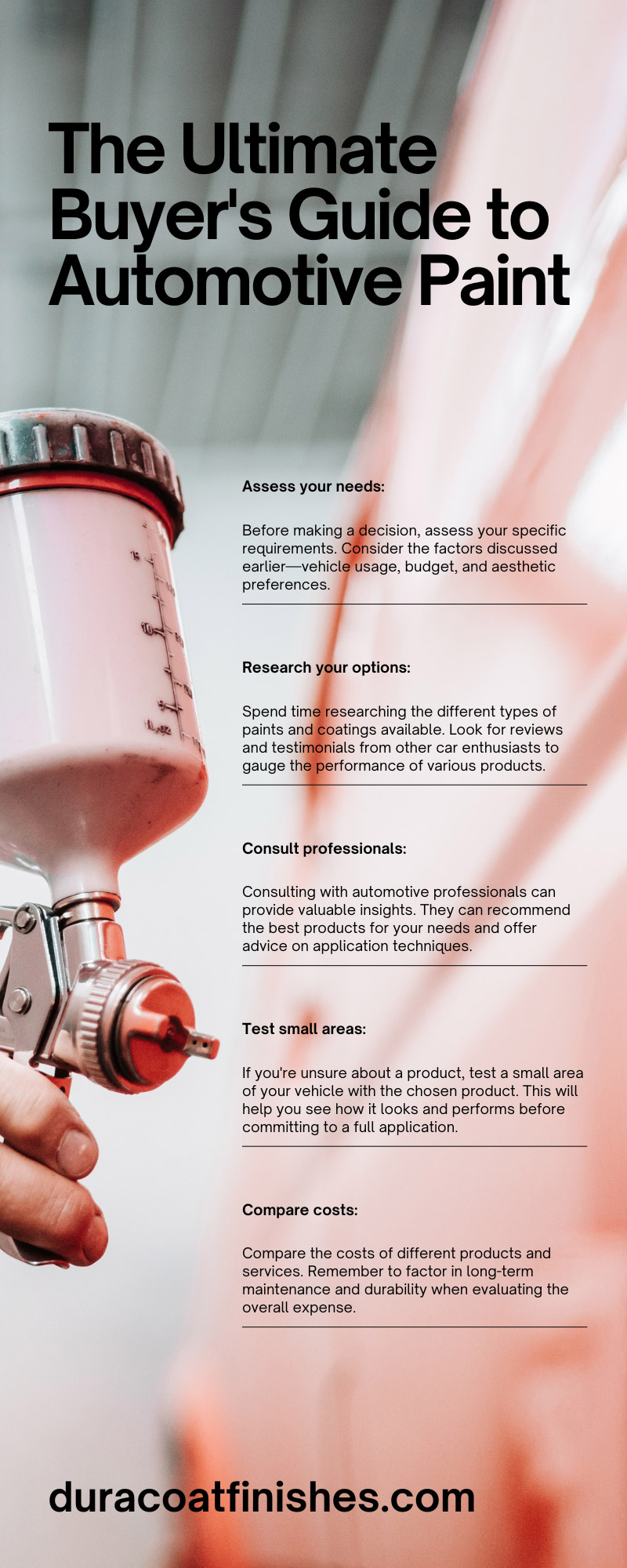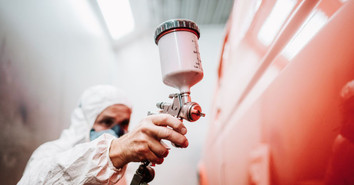When it comes to preserving the aesthetic appeal and long-term value of your vehicle, understanding the differences between automotive paint and performance finishes is essential. The right choice can enhance the overall look of your ride while providing robust protection against environmental factors, scratches, and wear over time.
Whether you're a car enthusiast looking to customize your vehicle or simply seeking to maintain its pristine condition, this ultimate buyer's guide to automotive paint will help you make an informed decision and achieve that showroom shine.
The Difference Between Conventional Paint and Performance Finishes
Conventional Paint
Conventional automotive paint typically consists of a base coat that provides color and a clear coat that offers protection and gloss. These paints are generally solvent-based and can be applied through various techniques, including spraying and rolling. One of the key characteristics of conventional paint is its ease of application and relatively low cost, making it a popular choice for both manufacturers and DIY enthusiasts.
However, while conventional paint can deliver a visually appealing finish, it may not offer the same level of durability and resistance to environmental elements as performance finishes. Factors such as UV exposure, chemicals, and physical abrasions can affect the longevity of conventional finishes, making it difficult to preserve the vehicle's appearance.
Performance Finishes
Performance finishes, on the other hand, are designed for those looking for enhanced durability and longevity. These finishes often incorporate advanced technology and premium materials that provide superior resistance to UV rays, chemicals, and scratches. Popular options include high-temperature coatings, enamels, and surface fillers, which form a robust protective layer over the vehicle's surface.
Unlike conventional paint, which may require frequent touch-ups and reapplications, performance finishes can offer long-lasting protection with minimal maintenance. Additionally, they often enhance overall aesthetic appeal, providing a deeper shine and more vibrant colors that stand the test of time. For car enthusiasts who desire the best for their vehicles, investing in performance finishes is an excellent choice to preserve both functionality and beauty.
Industries That Use Performance Finishes
Performance finishes are utilized across various industries due to their superior durability, resistance, and aesthetic qualities.
- Automotive: In the automotive sector, performance coatings protect vehicles from harsh environmental conditions, facilitate easier cleaning, and enhance appearance. They're particularly valued in premium and custom vehicle applications, where showcasing vibrant colors and maintaining a flawless finish are priorities.
- Powersports: The powersports industry, which encompasses motorcycles, ATVs, UTVs, and snowmobiles, relies heavily on performance coatings to withstand the rigors associated with off-road and high-performance environments. These vehicles are subjected to extreme conditions, making robust finishes essential for preserving both aesthetic appeal and structural integrity.
- Marine: Marine applications benefit from performance coatings that provide exceptional resistance to saltwater, UV exposure, and marine growth. These coatings are essential for protecting boats and ships, ensuring longer service life and better performance in wet or moist environments.
- Industrial: Manufacturing and heavy industries utilize performance coatings on machinery and tools to prevent wear, corrosion, and chemical damage. These coatings extend equipment lifespan and reduce maintenance costs, making them a smart investment for operational efficiency.
By understanding the diverse applications of performance coatings, buyers can better appreciate the benefits these advanced solutions offer beyond automotive finishes, making them an invaluable choice in many fields.
Factors to Consider When Choosing Paint or Performance Finishes
Vehicle Usage
When selecting the right paint or finish for your vehicle, it's essential to consider how you use your car. For everyday drivers that face varied weather conditions and potential wear and tear, a robust performance finish may provide the durability needed for long-term protection.
Additionally, if your vehicle regularly traverses rough terrains or urban environments, finishes with strong resistance to scratches, chips, and contaminants should be your preference to ensure your investment remains pristine.
Budget
Setting a realistic budget is a critical step in selecting the right paint or coating for your vehicle. Automotive finishes can vary significantly in price based on factors such as the type of product, brand, and application method. Conventional paints typically offer a more budget-friendly option, with a range of prices relative to the quality and brand. However, performance finishes are often preferred for their advanced formulations and application processes.
It's also important to factor in potential additional costs for professional application, as some finishes require expert installation to achieve the best results. Balancing your budget with your desired level of protection and aesthetic appeal will help ensure you make a choice that meets both your financial and automotive needs.
Aesthetic Preferences
Your aesthetic preferences play a significant role in choosing the right paint or coating for your vehicle. The finish you choose can dramatically impact the overall look and feel of your car, transforming it from a standard model into something uniquely yours. The addition of spray-on bluing or Parkerizing replicators can help you reflect your personality and style.
Other additions, such as chrome or gold topcoats, can further personalize your ride, but it's essential to ensure these choices not only suit your taste but also complement the car's original design. In some cases, restoration auto paint may be your best choice for achieving the classic look you want. Remember that while aesthetics are important, they should be balanced with functionality to ensure your selected finish not only looks great but also stands up to wear and environmental factors.
A Detailed Buyer's Guide
Whether you’re buying automotive paint or performance finishes, it's important to know what you're getting and how it will impact your vehicle. Here are some things to keep in mind:
- Assess your needs: Before making a decision, assess your specific requirements. Consider the factors discussed earlier—vehicle usage, budget, and aesthetic preferences.
- Research your options: Spend time researching the different types of paints and coatings available. Look for reviews and testimonials from other car enthusiasts to gauge the performance of various products.
- Consult professionals: Consulting with automotive professionals can provide valuable insights. They can recommend the best products for your needs and offer advice on application techniques.
- Test small areas: If you're unsure about a product, test a small area of your vehicle with the chosen product. This will help you see how it looks and performs before committing to a full application.
- Compare costs: Compare the costs of different products and services. Remember to factor in long-term maintenance and durability when evaluating the overall expense.
With these best practices in mind, you can ensure you get the result you want and keep your vehicle protected and looking good throughout its life.
Improving the Aesthetics and Durability of Vehicles
Choosing the right paint or finish for your vehicle is a critical decision that impacts both aesthetics and durability. With this buyer's guide to automotive paint, you can make an informed choice and achieve the best results for your vehicle.


